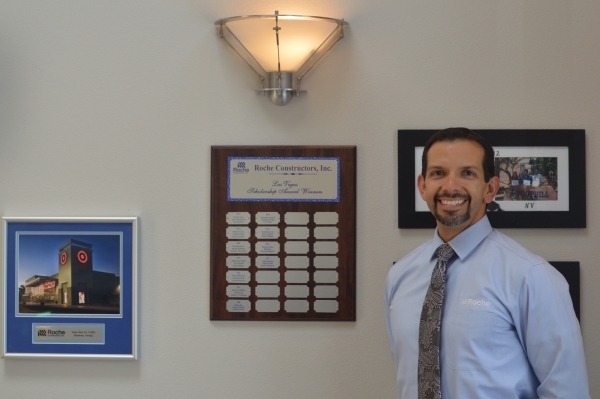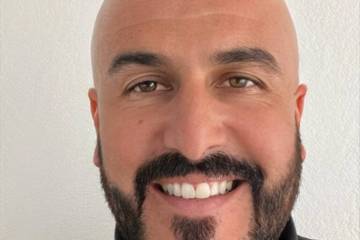
Eddie Castaneda is Roche Constructors Inc.’s project manager working on Opportunity Village’s Sean’s Park.
It’s a special project, built for children with special needs. And that presents both challenges and satisfaction, Castaneda said.
It is the first hands-on learning and recreational project of its kind, so Castaneda’s team is learning too.
The project taking shape on the grounds of Opportunity Village’s campus on South Buffalo Drive is the culmination of a six-year fundraising effort. About $4 million was raised, helped by a major gift by Michael Morrissey. The park is named after his son Sean, 29, an artist with intellectual disabilities who works at Opportunity Village’s fine arts studio.
The 2.5-acre park is expected to be completed in November.
Castaneda grew up in Arizona before attending Western New Mexico University in Silver City, where he received a mathematics degree. He went on to the University of Arizona to study civil engineering. He also earned a master’s in business administration from the University of Phoenix.
His career started on the civil engineering and design side of the business before he moved into an administrative/managerial role.
Q. What is unique about building this project, considering it’s designed for those with disabilities?
A. The unique part to Sean’s Park is the playground equipment. Stuff that we take for granted every day. Let’s go get on a swing, enjoy the swing … you learned how to swing on your own. Some of the kids have never experienced that before. There’s actually called a Freedom Swing that we’re going to install on this project. It’s essentially a person in a wheelchair can then wheel into it, lock themselves in place, and then there can be somebody to push, just like you or I would have when we were kids; have someone there with us to play and enjoy and get to experience … the freedom of air, the movement … I was super excited when I saw that thing was in there.
Q. What kind of safety issues did you have to consider with the Freedom Swing?
A. There’s definitely a radius around the swing itself, a safety radius. We’re putting a 3-foot high viewing fence … so that way patrons or other kids don’t get too excited and run in on foot and get hit by the swing. Keeping safety at the top of the list. On some of the playground equipment itself, we are actually doing about 20 inches worth of fall protection. It’s like a rubberized mat that’s going down over this whole surface area. There’ll be the shading structures above this equipment as well.
Q. What new methods, technology, or design are you using?
A. When it comes to design equipment or design techniques, design … is very architectural based or structural based or mechanical. Those guys design in either CAD, or they design in certain programs that they use specifically. Now as far as construction industry, general contractors side, what we wind up using a lot is On-Screen Takeoff, and that has helped huge for the general contractor as far as putting together the estimates, putting together the design piece — ‘here’s how this is played out,’ ‘here’s what color this is going to be,’ or ‘here’s what material is going to be here.’ And, it’s easy to be able to send stuff back and forth to the owner to say, ‘Hey I’m gonna change,’ instead of being on the phone with a vague ‘this area over on the left hand side’ or ‘go down this grid … over here to this number … that piece I’m going to turn it into a paver instead of concrete.’ You can actually color that … you can take a snapshot and send it via email.
Q. How fast is the technology advancing?
A. When I was in school, I was learning Auto CAD release like six or seven. When it’s DOS at its finest; when you had to type in all your commands. And it was, notepad on the side in order to say, ‘OK my next point is,’ and you’d type it out. The last release that I worked on was like Auto CAD 12. But now, I think they’re going up to 15. It’s like every six months to a year they come out with a new program. Essentially, Auto CAD is the automated drafting technology; so instead of doing the old-school hand draft, you can now do it all on computer which speed things up dramatically. As far as innovation, I know, those guys are very far in front of everybody.
Q. How does this help eliminate issues before they arise?
A. There’s another one (program) that’s out there, that they now do, essentially draw in 3-D, and then you can do clash detection so that when you’re running your pipes, it will tell you, ‘Hey this pipe is going to hit this pipe here; this pipe’s going to run into this wall, and you’ve got a main ceiling beam right there,’ which is pretty neat.
Q. What benefits of these computer programs offer to save the most money and increase production along or keep projects on schedule?
A. Clash detection, that’s within what they call BIM, building information modeling. Essentially what you’re doing is you’re now drawing in 3-D. The clash detection lets you figure out all your problems before you get into the field and your superintendent’s sitting there saying, ‘Hey wait a minute, if you run that pipe it’s going hit this; we need to move it. Let’s go ask the structural engineer,’ which then takes time, and that’s where delays in projects come from, so this can help speed the process along.
Q. What is the biggest misconception about building retail locations?
A. Everybody always says, ‘Oh the typical job,’ and you’re going to build a building. But every building is actually not typical because it’s the first time we’ve built that building. Even when we go build another, if it’s a Target store, even though we’re building that same exact Target store, in a new location, the municipalities will always say, ‘Oh we want the front to look slightly different,’ because ‘we want’ it Summerlin versus North Las Vegas versus Henderson. They’ll have their different styles they’ll want to put on it. Essentially, we’ve build the store before, but we’ve never built it like this.
Q. How does the technology help you when interacting with customers?
A. So what happens when you get to use this kind of technology is on the interior portion of it … you can virtually build it, show the owner, you can turn the thing all the way around 360. And then the person sitting across from me doesn’t have to have the imagination or the ability to look at a 3-D drawing and visually say, ‘Oh yeah I know what that’s going to look like’ because now you can show them 3-D version of what it’s going to look like.






